Students can access the CBSE Sample Papers for Class 12 Biology with Solutions and marking scheme Term 2 Set 8 will help students in understanding the difficulty level of the exam.
CBSE Sample Papers for Class 12 Biology Standard Term 2 Set 8 with Solutions
Time Allowed: 2 Hours
Maximum Marks: 40
General Instructions:
- All questions are compulsory.
- The question paper has three sections and 13 questions. All questions are compulsory.
- Section-A has 6 questions of 2 marks each; Section-B has 6 questions of 3 marks each, and Section-C has a case-based question of 5 marks.
- There is no overall choice. However, internal choices have been provided in some questions. A student has to attempt only one of the alternatives in such questions.
- Wherever necessary, neat and properly labeled diagrams should be drawn.
SECTION – A
(Section A has 6 Questions of 2 marks each.)
Question 1.
(A) It is always advised that breastfeeding is best for the newborn as breastfed babies tend to be more immune than the bottle-fed babies. Why?
(B) What do you mean by anamnestic response? (2)
Answer:
(A) Mother’s milk especially the colostrum (yellowish fluid) secreted during initial days of lactation by the mother which contains abundant antibodies (IgA) that gives protection to the infant. These antibodies are not available to the bottle-fed babies.
Related Theory:
When such ready-made antibodies are directly given to an individual to protect the body against foreign substances. Such kind of immunity is called as passive immunity. This type of immunity is fast-acting but it lasts for only few days/months.
(B) The anamnestic response is also known as secondary or booster immune response that occurs due to second or subsequent encounter with the same pathogen. As compared to a primary immune response which is of low intensity, the secondary response is highly intensified with a shorter lag period and greater production of antibodies and it lasts longer.
![]()
Question 2.
(A) Anshika’s mother explained her the formation of bread by showing the following pictures of the rising of the dough. Which microorganism is used for fermenting the dough in the making of bread?
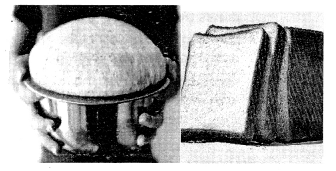
(B) What do you mean by toddy?
OR
Mention the role of baker’s yeast in the production of bread. (2)
Answer:
(A) For making bread, the dough is fermented using baker’s yeast, Saccharomyces cerevisiae.
(B) Toddy is a traditional drink of some parts of southern India which is made by fermenting sap from palm trees, coconut, etc.
OR
Saccharomyces cerevisiae, also known as Baker’s yeast, is responsible for the alcoholic fermentation of sugars in wheat flour, that produce ethanol and CO2. CO2 raises the bread when baked and makes it soft.
Question 3.
The given picture shows a keystone species – sea otter along with other species like kelp and sea urchin. What do you mean by keystone species and what is its importance? (2)
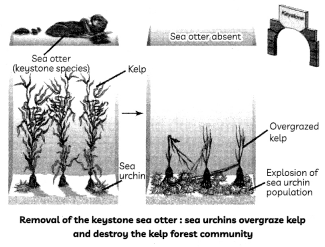
Answer:
A keystone species is an organism which helps to define an entire ecosystem. It plays vital role in sustaining the community. The ecosystem would be dramatically different or cease to exist altogether, without its keystone species. This means that if the species disappear from the ecosystem, no other species would be able to fill its ecological niche.
Example: Sea otter is the keystone species and in its absence, the sea urchins overgraze kelp and destroy the kelp forest community.
Question 4.
People usually discriminate individuals suffering from AIDS due to certain misconceptions and finally it leads to social boycott of such individuals.
Do you think this is ethically correct? If not, why? Suggest one preventive measure for the disease. (2)
Answer:
No, it is not ethically correct at all. An individual suffering from AIDS should not be discriminated as it is like any other disease. AIDS is not contagious, i.e., it does not spread by shaking hands, talking or using common utensils.
Preventive measures are as follows:
- Making blood (from blood banks) safe from HIV.
- Use of only disposable needles and syringes in public and private hospitals and clinics is ensured.
- Condoms are distributed free of cost and safe sex is being advocated.
- Controlling drug abuse.
- Promotion of regular check-ups for HIV in susceptible populations. (Anyone)
Question 5.
Describe the chemical method of making cells competent for transformation with recombinant DNA.
OR
Which category of enzymes is termed as ‘molecular glue’ and why? (2)
Answer:
In the chemical method or CaCl2 method, the cells are treated with a specific concentration of a divalent cation, such as calcium, that increases the efficiency with which the DNA enters through the pores present in the bacterial cell walls. Recombinant DNA is then forced into such cells by incubating the cells with recombinant DNA on ice first, and then they are given heat shock by placing them at 42°C for a short duration, and then putting them back on ice. This enables the bacteria to take up the recombinant DNA.
OR
DNA ligases are termed as ‘molecular glue’ as they repair broken DNA by joining two nucleotides.
It is used in rDNA technology or genetic engineering to reverse the action of restriction enzymes by joining the complementary DNA strands or ends together. Example: T4 DNA Ligase.
![]()
Question 6.
During a visit to a national park, teacher was explaining about ecological niche, habitat, etc., specify the difference between an ecological niche and habitat. (2)
Answer:
The difference between an ecological niche and habitat is as follows:
| Niche | Habitat |
| It is defined as the particular area within a habitat or physical space occupied by an organism. Niche of an organism comprises of an invariably defined range of conditions that the organism can tolerate, diversity in the resources it utilises and a
distinct physical and functional rote in the ecological system. |
It refers to a specific space or place where in an organism Lives, grows, adapts and reproduces. Various abiotic factors like temperature, sunlight. rainfall types of soil, etc., determine the presenœ of organisms present in an area. |
SECTION – B
(Section B has 6 Questions of 3 marks each.)
Question 7.
(A) What do you mean by Bioconversion?
(B) Name two commonly used vectors in rDNA technology.
(C) How many fragments will be produced when a linear DNA and a plasmid DNA having three restriction sites for EcoRI are cut with the restriction enzyme? (3)
Answer:
(A) Bioconversion refers to the process by which organic materials such as plant or animal waste are converted to specific usable products by biological processes or microbial, activity.
(B) The two commonly used vectors in rDNA technology are Plasmid and Bacteriophage.
(C) Number of fragments produced in linear DNA are 4. Number of fragments produced in a plasmid are 3.
Question 8.
There is always an increasing demand of food supply in our country. A farmer has mainly three options to increase the food production. List these three options. (3)
Answer:
To increase the food production there are following three options:
- Agro-chemical-based agriculture.
- Organic agriculture.
- Genetically engineered crop-based agriculture.
Question 9.
The following pictures show the symptoms of some diseases such as sneezing in case of common cold and skin rash in case of chikungunya. Write the mode of transmission of infection for the following diseases: (3)
(A) Common cold
(B) Chikungunya
(C) Ascariasis
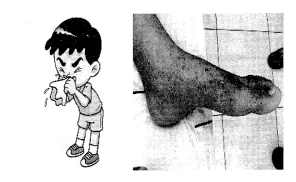
Answer:
The mode of transmission of infection for the following diseases is as follows:
| Disease | Mode of transmission |
| Common cold | It spreads through droplets resulting from cough or sneezes of an infected person (droplet infection) or through contaminated objects such as pens, books, cups, doorknobs, computer keyboard or mouse, etc. |
| Chikungunya | It is transmitted by the bite of Aedes aegypti mosquito. |
| Ascariasis | Gets transmitted when a healthy person consumes water, vegetables, fruits, etc., or gets exposed to soil, water, plants, etc., that are contaminated with the fecal matter of infected persons contains eggs of the parasite. |
![]()
Question 10.
Suresh was observing that in a field, insects were not able to infect the plants, instead, insects were killed on eating the plants. Explain the reason why it happened? Give some examples of such crops. (3)
Answer:
When the insects were not able to infect the plants and were getting killed upon eating them is because of a reason that such plants are geneticalLy modified pest-resistant plants that produce a toxin that kills insects when they feed on them.
Bacillus thuringiensis (Bt) is a bacterium that produces a toxin named Bt toxin. This toxin is fatal for insects, therefore, Bt-toxin gene has been cloned from the bacteria and expressed in plants to provide resistance to insects without the need for insecticides. Thus, it is called as a biopesticide.
Examples: Bt cotton, Bt corn, Bt rice, Bt tomato, Bt potato, and Bt soybean, etc.
Question 11.
Which are the three types of age pyramids? Depict each of them with a diagram. (3)
Answer:
The age pyramids can be classified into three categories:
- Expanding or growing
- Stable
- Declining

Related Theory
Age pyramid is formed when the age distribution i.e., percent individuals of a given age or age group is plotted for the population.
Question 12.
Elaborate with the help of examples that alien species are highly invasive and are a threat to indigenous species.
OR
List any three consequences of the loss of biodiversity? (3)
Answer:
It has been seen for a long time that when alien species are introduced unintentionally or deliberately for any purpose, some of them become invasive, and cause decline or extinction of indigenous species.
Example:
(i) In East Africa, introduction of the Nile perch into Lake Victoria eventually led to the extinction of an ecologically unique assemblage of more than 200 species of cichlid fish in the lake.
(ii) In India, the introduction of the invasive weed species like carrot grass (Parthenium), Lantana and water hyacinth (Eichhornia) led to the environmental damage and posed a threat to our native species.
(iii) The recent illegal’ introduction of the African catfish Clarias gariepinus for aquaculture purposes is posing a threat to the indigenous catfishes in Indian rivers.
OR
The consequences of loss of biodiversity:
(i) Declining biodiversity lowers the quality of the ecosystem’s services which often include maintaining the soil, purifying water that runs through it, and supplying food and shade, etc.
(ii) Loss of biodiversity results in the extinction of many species.
(iii) Human beings are very much dependent on biodiversity for food and other requirements, therefore, its loss will be hard-pressed for mankind.
SECTION – C
(Section C has a case-based question of 5 marks.)
Question 13.
In order to spread awareness regarding organic farming, students pasted the following posters inside and outside the school campus. answer the following Based on this questions:
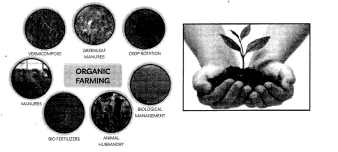
(ii) How do organic farmers manage fertility?
(B) How are crop damage by insect pests managed on organic farms?
OR
(A) (I) What is organic agriculture?
People extensively use antibiotics for the treatment of several diseases. Komal knows that antibiotics are produced by microbes and are very useful to treat many diseases Based on this answer the following questions:
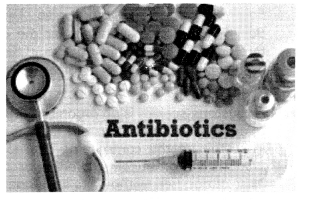
(A) What are antibiotics?
(B) How does antibiotic resistance happen?
(C) What precautions must be taken while taking antibiotics? List any two. (5)
Answer:
(A)
- Organic agriculture is a system of farming that mimics natural ecosystems. It balances pest and beneficial organism population and maintains and replenishes fertility of the soil.
- Organic farmers manage fertility or crop nutrients through crop rotation, which includes application of plant and animal organic matter, generally in the form of compost. Soil structure, organic matter content and soil microbial life is improved by appropriate tillage and cultivation practices.
![]()
(B) In organic farming crop damage by insect pests is prevented primarily through the use of natural pesticides (mainly extracted from plant or animal origins), biological and cultural practices such as crop rotation; habitat management; beneficial organism releases; sanitation; and timing.
OR
(A) Antibiotics are the chemical substances that are produced by some microbes and can kill or retard the growth of other (disease-causing) microbes.
(B) On exposure to antibiotics, bacteria can develop ways to escape their effects. We should be careful about how we use antibiotics because bacteria are able to adapt. Using antibiotics when they are not necessary may cause them to become ineffective when they are really needed. A person does not become resistant to an antibiotic, but the bacteria become resistant to treatment.
(C) The precautions that should be taken while taking antibiotics are:
- Antibiotics should be taken only when advised by a qualified doctor.
- A person must complete the full course of antibiotics as prescribed by doctor.
- Antibiotics should be taken in proper doses.
- Antibiotics should not be taken unnecessarily as it can kill the useful bacteria in the body.